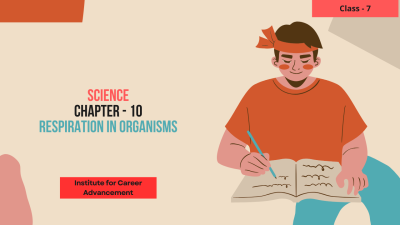Course description
Here’s an overview of what students might learn:
Introduction to Respiration:
Definition of Respiration:
Understand respiration as the biochemical process through which cells obtain energy from organic molecules (usually glucose) by converting it into ATP (adenosine triphosphate), the energy currency of cells.
Types of Respiration:
Aerobic Respiration: Learn about aerobic respiration, which occurs in the presence of oxygen and involves the complete breakdown of glucose into carbon dioxide and water, releasing energy.
Anaerobic Respiration: Introduce anaerobic respiration, where organisms can generate energy without oxygen, producing by-products such as lactic acid (in animals) or ethanol and carbon dioxide (in yeast and some bacteria).
Steps and Processes:
Glycolysis:
Understand the initial step of glucose breakdown, glycolysis, which occurs in the cytoplasm and produces pyruvate molecules and a small amount of ATP.
Krebs Cycle (Citric Acid Cycle):
Explore the aerobic pathway where pyruvate from glycolysis is further broken down in the mitochondria to produce more ATP, carbon dioxide, and high-energy electrons used in the electron transport chain.
Electron Transport Chain:
Discuss the final stage of aerobic respiration where electrons from the Krebs cycle are transported through a series of protein complexes in the mitochondria membrane, generating ATP via oxidative phosphorylation.
Fermentation:
Explain the anaerobic pathways in organisms that lack oxygen, including alcoholic fermentation (yeast) and lactic acid fermentation (muscle cells), focusing on the production of ATP and waste products.
Respiratory Structures in Organisms:
Respiratory Organs:
Identify and compare respiratory structures in different organisms, such as lungs in mammals, gills in fish, tracheal systems in insects, and moist skin in amphibians, emphasizing adaptations for efficient gas exchange.
Mechanisms of Breathing:
Discuss the mechanisms of breathing and how organisms maintain respiratory surfaces for gas exchange, including factors like surface area, diffusion gradients, and adaptations for oxygen uptake.
Energy and Metabolism:
Role of ATP:
Explain the importance of ATP as the energy currency of cells and its role in cellular processes like muscle contraction, active transport, biosynthesis, and maintaining cellular functions.
Metabolic Pathways:
Explore how respiration connects with other metabolic pathways such as photosynthesis, cellular metabolism, and the regulation of energy balance in organisms.
শিক্ষার্থীরা কী শিখতে পারে তার একটি সংক্ষিপ্ত বিবরণ এখানে দেওয়া হল:
শ্বাসপ্রশ্বাসের ভূমিকা:
শ্বাস-প্রশ্বাসের সংজ্ঞা:
শ্বসনকে জৈব রাসায়নিক প্রক্রিয়া হিসাবে বুঝুন যার মাধ্যমে কোষগুলি এটিপি (এডিনোসিন ট্রাইফসফেট), কোষের শক্তি মুদ্রায় রূপান্তর করে জৈব অণু (সাধারণত গ্লুকোজ) থেকে শক্তি গ্রহণ করে।
শ্বাসপ্রশ্বাসের ধরন:
বায়বীয় শ্বসন: বায়বীয় শ্বসন সম্পর্কে জানুন, যা অক্সিজেনের উপস্থিতিতে ঘটে এবং কার্বন ডাই অক্সাইড এবং জলে গ্লুকোজের সম্পূর্ণ ভাঙ্গন, শক্তি নির্গত করে।
অ্যানেরোবিক শ্বসন: অ্যানেরোবিক শ্বসন প্রবর্তন করুন, যেখানে জীব অক্সিজেন ছাড়াই শক্তি উৎপন্ন করতে পারে, ল্যাকটিক অ্যাসিড (প্রাণীদের মধ্যে) বা ইথানল এবং কার্বন ডাই অক্সাইড (খামির এবং কিছু ব্যাকটেরিয়াতে) এর মতো উপজাত উত্পাদন করতে পারে।
পদক্ষেপ এবং প্রক্রিয়া:
গ্লাইকোলাইসিস:
গ্লুকোজ ভাঙ্গনের প্রাথমিক ধাপ, গ্লাইকোলাইসিস, যা সাইটোপ্লাজমে ঘটে এবং পাইরুভেট অণু এবং অল্প পরিমাণে এটিপি তৈরি করে তা বুঝুন।
ক্রেবস চক্র (সাইট্রিক অ্যাসিড চক্র):
বায়বীয় পথটি অন্বেষণ করুন যেখানে গ্লাইকোলাইসিস থেকে পাইরুভেট আরও বেশি ATP, কার্বন ডাই অক্সাইড এবং ইলেকট্রন পরিবহন শৃঙ্খলে ব্যবহৃত উচ্চ-শক্তি ইলেকট্রন তৈরি করতে মাইটোকন্ড্রিয়াতে ভেঙে যায়।
ইলেকট্রন পরিবহন শৃঙ্খল:
বায়বীয় শ্বাস-প্রশ্বাসের চূড়ান্ত পর্যায়ে আলোচনা কর যেখানে ক্রেবস চক্র থেকে ইলেকট্রনগুলি মাইটোকন্ড্রিয়া ঝিল্লিতে প্রোটিন কমপ্লেক্সের একটি সিরিজের মাধ্যমে পরিবাহিত হয়, যা অক্সিডেটিভ ফসফোরিলেশনের মাধ্যমে এটিপি তৈরি করে।
গাঁজন:
অ্যালকোহলযুক্ত গাঁজন (খামির) এবং ল্যাকটিক অ্যাসিড গাঁজন (পেশী কোষ) সহ অক্সিজেনের অভাব রয়েছে এমন জীবের অ্যানেরোবিক পথগুলি ব্যাখ্যা করুন, এটিপি এবং বর্জ্য পণ্য উত্পাদনের উপর দৃষ্টি নিবদ্ধ করুন।
জীবের শ্বাসযন্ত্রের গঠন:
শ্বাসযন্ত্রের অঙ্গ:
স্তন্যপায়ী প্রাণীর ফুসফুস, মাছের ফুলকা, পোকামাকড়ের শ্বাসনালী সিস্টেম এবং উভচর প্রাণীদের আর্দ্র ত্বকের মতো বিভিন্ন জীবের শ্বাস-প্রশ্বাসের কাঠামো সনাক্ত করুন এবং তুলনা করুন, দক্ষ গ্যাস বিনিময়ের জন্য অভিযোজনের উপর জোর দিন।
শ্বাস প্রশ্বাসের প্রক্রিয়া:
শ্বাস-প্রশ্বাসের প্রক্রিয়া এবং কীভাবে জীবগুলি গ্যাস বিনিময়ের জন্য শ্বাসপ্রশ্বাসের পৃষ্ঠতল বজায় রাখে তা আলোচনা করুন, যার মধ্যে রয়েছে পৃষ্ঠের ক্ষেত্রফল, প্রসারণ গ্রেডিয়েন্ট এবং অক্সিজেন গ্রহণের জন্য অভিযোজন।
শক্তি এবং বিপাক:
ATP এর ভূমিকা:
কোষের শক্তির মুদ্রা হিসাবে ATP এর গুরুত্ব এবং পেশী সংকোচন, সক্রিয় পরিবহন, জৈব সংশ্লেষণ এবং সেলুলার ফাংশন বজায় রাখার মতো সেলুলার প্রক্রিয়াগুলিতে এর ভূমিকা ব্যাখ্যা করুন।
বিপাকীয় পথ:
সালোকসংশ্লেষণ, সেলুলার মেটাবলিজম এবং জীবের শক্তির ভারসাম্য নিয়ন্ত্রণের মতো অন্যান্য বিপাকীয় পথের সাথে শ্বসন কীভাবে সংযোগ করে তা অন্বেষণ করুন।



















